Tennessee Walking Horse
Equus ferus
There's a national celebration of Tennessee Walkers each year
Advertisement
Tennessee Walking Horse Scientific Classification
- Kingdom
- Animalia
- Phylum
- Chordata
- Class
- Mammalia
- Order
- Perissodactyla
- Family
- Equidae
- Genus
- Equus
- Scientific Name
- Equus ferus
Read our Complete Guide to Classification of Animals.
Tennessee Walking Horse Conservation Status
Tennessee Walking Horse Facts
- Name Of Young
- Foal
- Group Behavior
- Social
- Fun Fact
- There's a national celebration of Tennessee Walkers each year
- Estimated Population Size
- Unknown
- Biggest Threat
- None
- Most Distinctive Feature
- Long neck
- Other Name(s)
- Tennessee walking horse
- Gestation Period
- 320-370 days
- Litter Size
- 1
- Habitat
- Farms, ranches, pastures
- Predators
- None
- Diet
- Herbivore
- Favorite Food
- Grass, hay
- Type
- Mammal
- Common Name
- Tennessee walker
- Number Of Species
- -1
- Location
- North America
Tennessee Walking Horse Physical Characteristics
- Color
- Brown
- Grey
- Black
- White
- Blonde
- Skin Type
- Hair
- Top Speed
- 30 mph
- Lifespan
- Up to 30 years
- Weight
- 900-1200 lbs
- Height
- 59 inches – 68 inches
- Age of Sexual Maturity
- 13 months
- Age of Weaning
- 5 to 7 months
View all of the Tennessee Walking Horse images!
“The Tennessee Walking Horse is known for its unique running walk.”
Tennessee Walking horses, aka Tennessee Walkers, are friendly, docile horses with three types of gaits. They have long, elegant necks and can be dark brown, black, white, palomino, or gray in color. Tennessee Walkers are popular as both show horses and horses ridden for pleasure. They have a lifespan of up to 30 years when they receive excellent care. The origin story of this majestic horse goes back to the 18th century.
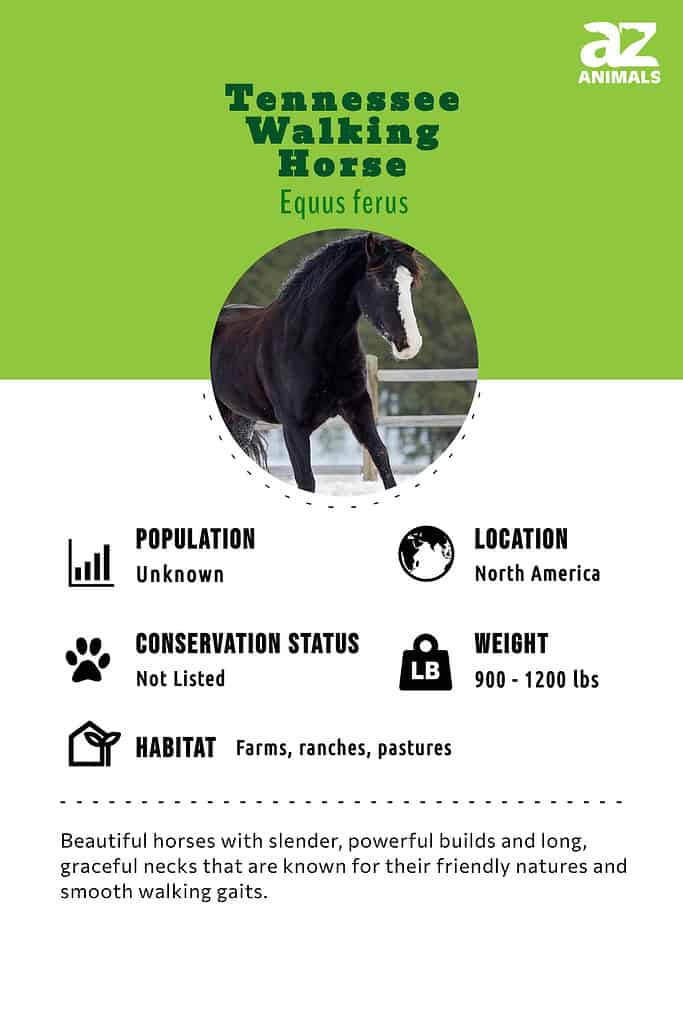
5 Tennessee Walker Facts
- It is known as an especially intelligent horse.
- Tennessee Walkers have a unique gait called the running walk.
- Some of these horses have suffered physical abuse known as soring in an effort to exaggerate their running walk gait.
- The first official national celebration of these horses took place in 1939.
- Singer Roy Roger’s horse Trigger Jr. was a Tennessee Walker.
Scientific Name
Equus ferus is the scientific name for a horse. The Latin word Equus means horse and the word ferus translates to wild. But the Tennessee Walker is a domesticated horse.
A Tennessee Walker is sometimes called a Tennessee Walking horse or a TWH. It belongs to the Equidae family and the Mammalia class.
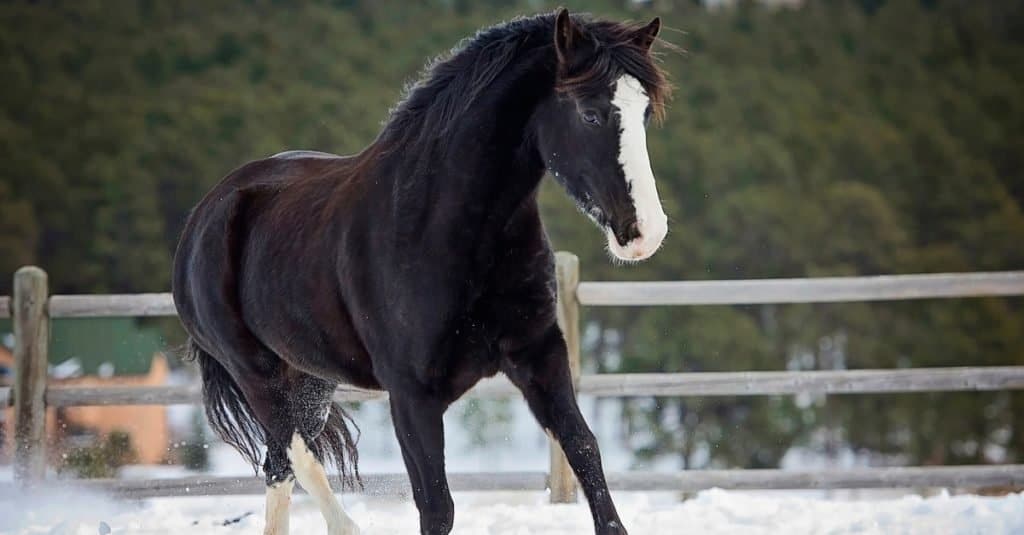
Tennessee Walkers have a reputation for having a calm disposition and a naturally smooth riding gait.
©OryPhotography/Shutterstock.com
Evolution
The Tennessee Walker is a composite breed that evolved from the Canadian Pacer, Morgan, Narragansett Pacer, Standardbred, American Saddlebred, Thoroughbred, and possibly, the Mustang. It could be said that it originated from all ancestors that could do a running walk.
What is a Running Walk?
The running walk is a natural gait that may be improved but not acquired by a horse without the natural ability. Tennessee Walking Horses have been bred to have this trait. The gait is faster than a flat-footed walk with a speed of up to 8 miles an hour. The front foot strikes the ground an instant before the hind foot – producing a low, gliding, reaching action.
Many Breeders Worked for Years to Create a Distinct Breed
Breeders in the Tennessee bluegrass region combined horses of several different breeds that possessed the ability to perform the running walk to produce the Tennessee Walking Horse – one of the greatest show and riding horses in the world.
When considering the evolution of a great domestic horse breed – it is important to remember that many people were involved before the official declaration of the breed in 1935. In fact, many breeders had combined efforts to produce the Tennessee Pacer – also known for its running walk. In 1885, a cross between a stallion named Allendorf, from the Hambletonian family of trotters, and Maggie Marshall, a Morgan mare, produced a black colt with a white blaze, off hind coronet and near hind sock named Black Allan. He was later to be chosen by the Tennessee Walking Horse Breeder’s Association as the foundation sire of the Tennessee Walking Horse – F-1. It was a cross between Allan and the Tennessee Pacer that produced today’s Tennessee Walking Horse.
Appearance & Behavior
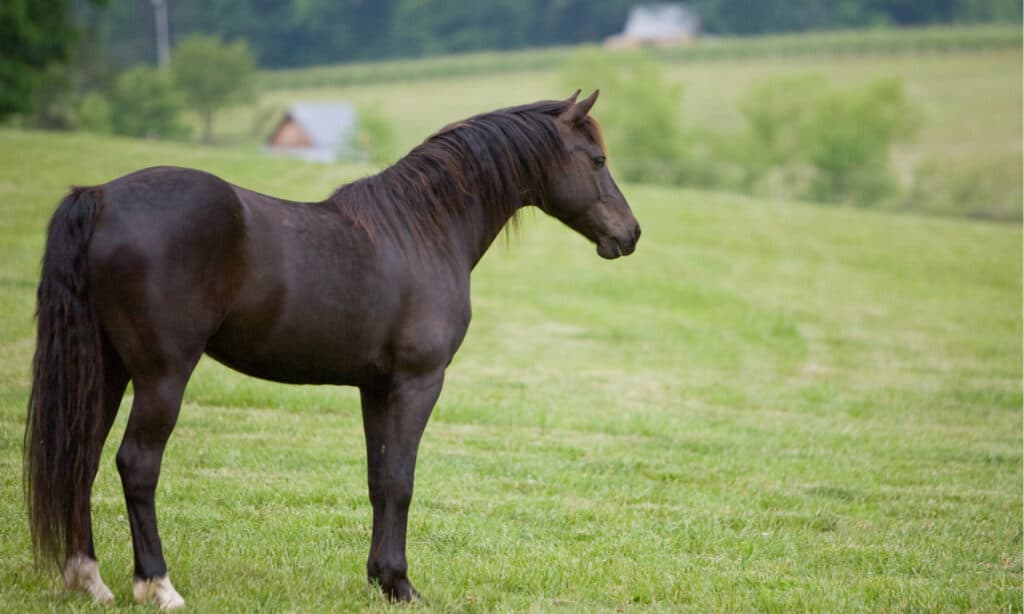
Tennessee Walkers have a slender, yet powerful build and long, graceful necks.
©Teri and Jackie Soares/Shutterstock.com
Tennessee Walkers have a coat of dark brown, black, white, palomino, or gray color. This horse has a long neck as well as a flowing mane and tail. It has a slender, yet powerful build.
These horses measure between 59 and 68 inches in height. Keep in mind that a horse’s height is measured from the ground up to its withers (the area at the bottom of its neck). Furthermore, most horse owners measure their horse’s height in hands instead of inches. One hand is equal to four inches. So, simply divide a horse’s height in inches by four. As an example, a horse measuring 60 inches tall would be 15 hands. The weight of a Tennessee Walker ranges from 900 to 1,200 pounds. The tallest Tennessee Walker is 68 inches at its withers.
A Tennessee Walker measuring 60 inches tall is the same height as one-fourth of an adult giraffe. Furthermore, a Tennessee Walker weighing 1,000 pounds is the same weight as a grand piano!
Zebras are close relatives of horses. As a comparison, a zebra weighs from 440 lbs to 992 lbs and is 43 inches to 60 inches tall at its withers. As you see, even the biggest zebra is smaller than a Tennessee Walker.
Like other horses, Tennessee Walkers are social animals. If they aren’t in a stable or pasture with their fellow horses, they’ll whinny and call to each other. A group of horses is called a herd. In the wild, horses move in a herd as a way to protect themselves against predators. Domesticated horses carry on this behavior out of natural instinct.
Tennessee Walkers have a gentle nature and are friendly. But a female horse with a baby or foal may become aggressive if she feels her young is being threatened by a person or another horse. No matter their size, all horses can kick or bite with force.
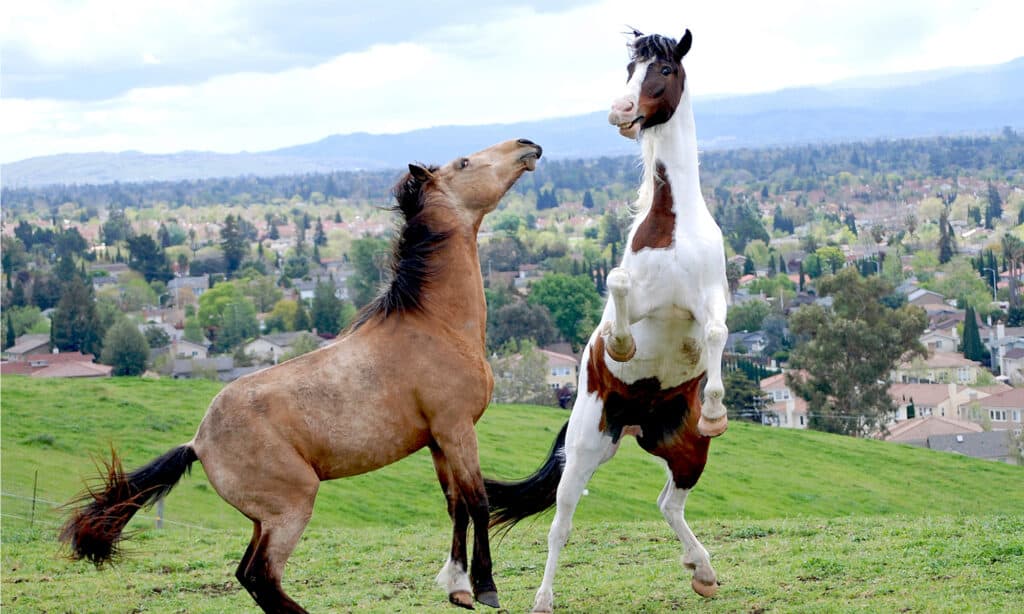
Tennessee Walkers need lots of space to exercise, socialize, and play.
©Horse Crazy/Shutterstock.com
Habitat
Tennessee Walkers live on farms and ranches. Some owners keep their horses in stalls inside a barn for part of the time, then let them out in the fields to exercise. As with most horses, Tennessee Walkers need plenty of space to move around. These popular horses are owned throughout the United States.
Predators and Threats
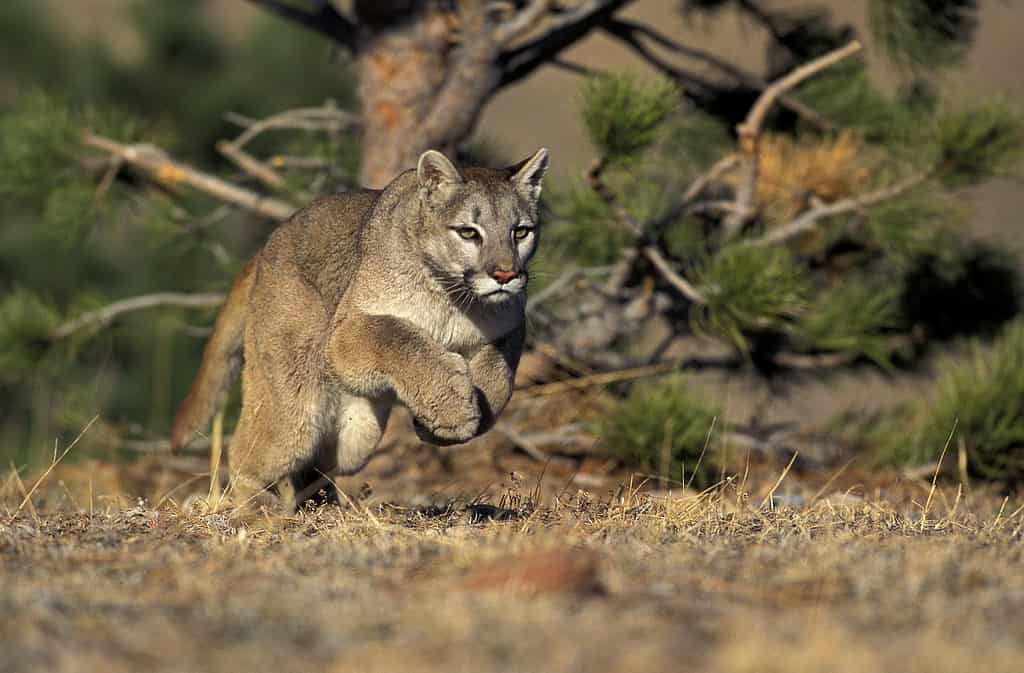
Mountain lions can reach 50 mph in short bursts and have been known to prey on wild horses.
©iStock.com/slowmotiongli
What eats Tennessee Walkers?
Hopefully, nothing! Wild horses are vulnerable to attack by mountain lions and other big cats depending on where they live. But, since Tennessee Walkers are domesticated horses, they don’t encounter the threat of these predators.
Other Threats
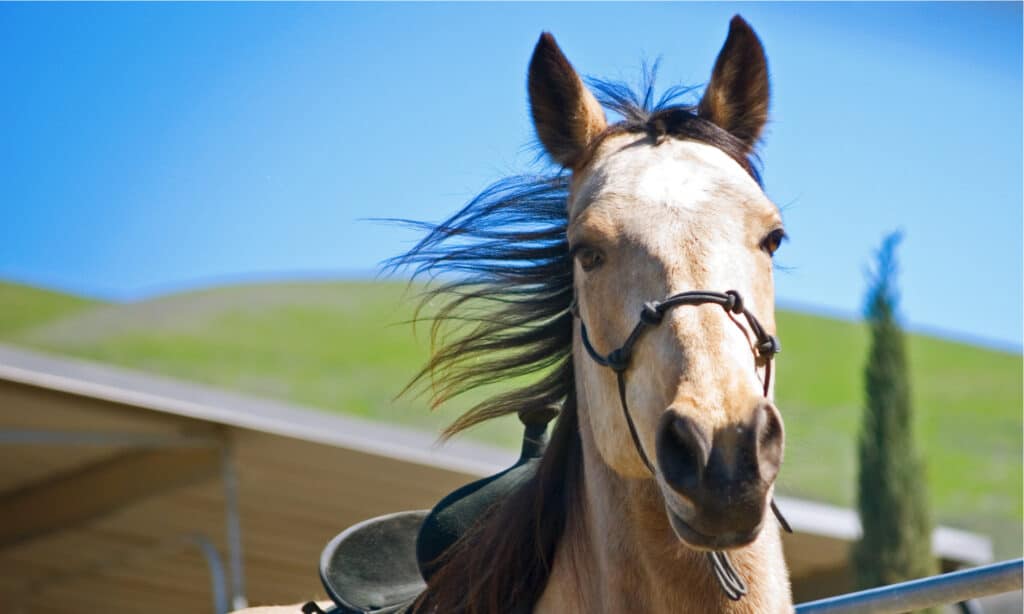
Tennessee Walkers suffer if their humans subject them to the practice of soring to make them lift their legs higher in competition.
©Horse Crazy/Shutterstock.com
One notable threat to Tennessee Walkers is perpetrated by humans. This abuse comes in the form of soring. Soring is the act of putting nails or harsh chemicals inside or on Tennessee Walker’s front hooves. This is done to make the horse lift its hooves higher while performing its running walk and other unique gaits.
Not surprisingly, soring makes it very painful for this horse to put its front hooves down, so it lifts its hooves higher in an effort to relieve the pain. This exaggerated movement gets the attention of horse show judges and in the past has given a competitor an advantage over other horses in the show. But, in reality, it is a terrible form of animal abuse.
Tennessee Walkers are popular horses shown in competition and kept as pets. These horses are admired and celebrated! The Tennessee Walking Horse National Celebration in Tennessee draws over a hundred thousand visitors each year!
Diet

The specific diet of a Tennessee Walker depends on its owner. Generally, these horses eat hay, grain, and grass out in a pasture, meadow, or field.
Reproduction, Babies, and Lifespan
Some owners breed Tennessee Walkers and sell them. In order to keep the breed pure, the male and female bred must be officially registered as Tennessee Walkers. Breeding two Tennessee Walkers mean the foal is sure to have the beloved traits of this type of horse.
The gestation period of a female Tennessee Walker is between 320-370 days. As a comparison, a zebra’s gestation period is longer at 358 to 438 days.
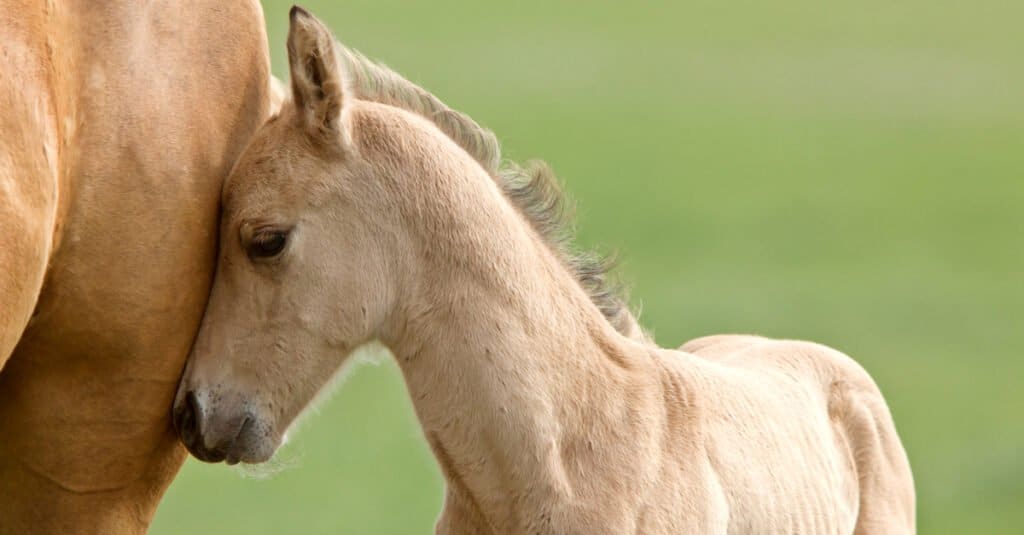
Foals are dependent on their mothers for around seven months but continue to socialize if they are kept in the same pasture.
©Pictureguy/Shutterstock.com
A female Tennessee Walker gives live birth to one baby or foal. A newborn foal weighs about 10 percent of its mother’s total weight. So, if a female Tennessee Walker weighs 1000 pounds, then her newborn is going to weigh around 100 pounds.
A Tennessee Walker foal tries to stand up immediately after its mother cleans the afterbirth off its coat. They are able to see and hear from birth. Most foals are able to stand and begin to walk in under an hour after birth. Though these domesticated animals aren’t in any danger from predators, it’s a natural instinct of these mammals to get up off the ground as soon as possible to avoid threats from predators. The foal begins to nurse from its mother right away.
Foals stay near their mother and nurse until they are weaned at five to seven months old. In fact, by five months, the foal is likely eating grass or hay alongside its mother in the field. Once a foal is weaned, it can get along on its own. But, if a mother and the foal are kept in the same barn or pasture, the foal is likely to call to its mother for attention.
Because of its unique gaits, a Tennessee Walker is more prone to back issues than other horses. These issues are exacerbated by the practice of soring. Tennessee Walkers have a lifespan going up to 30 years.
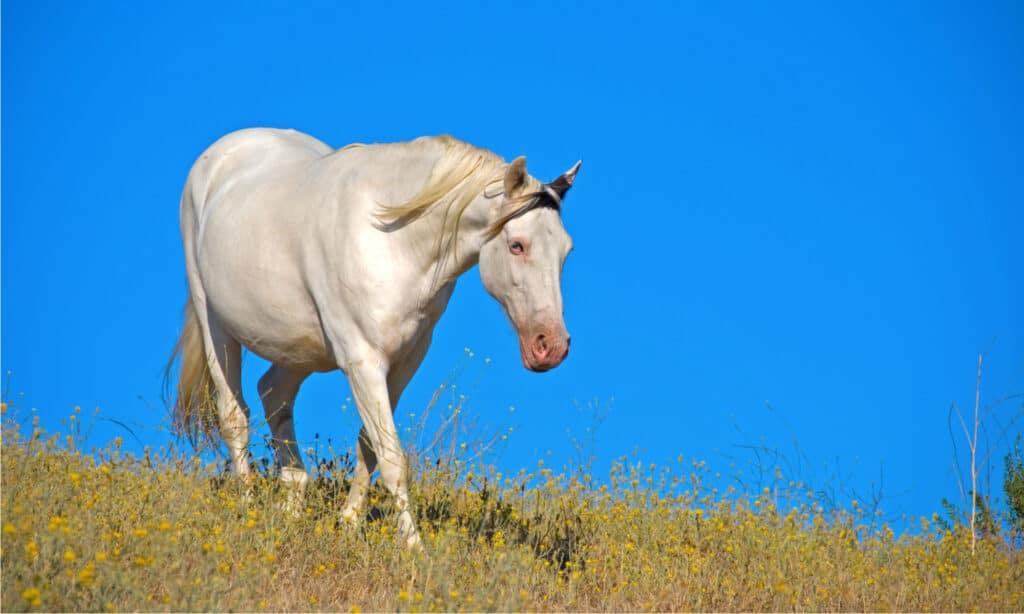
The Tennessee Walker is the third most popular horse in the United States.
©Horse Crazy/Shutterstock.com
Population
The Tennessee Walker claims the third-highest horse population in the United States. In fact, there were over 190,000 Tennessee Walkers in Tennessee as of the year 2000.
View all 133 animals that start with TTennessee Walking Horse FAQs (Frequently Asked Questions)
What is a Tennessee Walking horse?
A Tennessee Walker is a breed of horse with three unique gaits. These gaits are the flat foot walk, running walk, and the canter. They are smooth, controlled movements that set this horse apart from many other breeds.
When it comes to the color of its coat, Tennessee Walkers can be palomino, dark brown, black, white or gray. There are so many beautiful color combinations. One Tennessee Walker may be palomino with a cream-colored mane and tail. Another one may have a solid black coat, mane, and tail with just a little splash of white on its face. When the mother and father are registered as pure Tennessee Walkers, then the foal is one as well.
The Tennessee Walking horse is named after the state where it was first bred. The origin of this horse breed goes back to the late 18th century. It’s the product of breeding a Spanish mustang with a Narragansett Pacer.
Today, these gentle, easy-going horses are favorites for showing in competitions or just riding around for fun.
Are Tennessee Walkers carnivores, herbivores, or omnivores?
Tennessee Walkers are herbivores. They eat grass, and hay and some owners feed them grain as well.
Are Tennessee Walking horses illegal?
No, owning this horse is not illegal. However, there are laws against the practice of soring Tennessee Walkers or any other type of horse. Soring is when an owner puts objects or chemicals on or inside a Tennessee Walker’s front hooves to make the horse lift its feet higher than normal. It’s a form of abuse and painful to the horse.
A stacked shoe is an example of something attached to this horse’s front hooves to make it step higher. These are not comfortable or safe for the horse.
What is a Tennessee Walking horse used for?
Tennessee Walkers are shown in competitions. The horses are judged on the smoothness and ease of their gaits. Their gaits include the flat foot walk, running walk, and the canter. Its canter is sometimes compared to the motion of a rocking horse because the Tennessee Walker’s body has a rolling movement. A rider is judged on how easily he or she controls the horse and the person’s lack of movement in the saddle.
Tennessee Walkers are also used as pleasure horses. Many riders use them for trail-riding. Other horse owners show their Tennessee Walkers and use them for casual riding or for teaching inexperienced riders.
Though the delicate movements of Tennessee Walkers make them look like they belong in a show ring, they were originally bred to work on ranches. Their easy movements, intelligence, and even temperament made these horses a favorite with many ranchers.
Are there still Tennessee Walking horses?
Yes. Tennessee Walkers are very popular horses mostly due to their easy-going, gentle nature. This is a big reason why they are so commonly used as trail horses. They are slow to react to branches falling, leaves rustling, and other natural sounds in the woods. Other breeds of horses are easily startled by these noises.
Adding to that, the Tennessee Walker is the state horse of Tennessee.
Why is it called a Tennessee Walking horse?
One reason is that they were originally bred in the state of Tennessee. Secondly, they have a lively walking gait called the running walk, which is distinctive to this type of horse.
What breeds make up the Tennessee Walker?
The origin of this horse started with the idea of breeding a Narragansett Pacer with a Spanish mustang. The combination of these two breeds made the Tennessee Walker an intelligent horse with smooth, easy gaits.
Thank you for reading! Have some feedback for us? Contact the AZ Animals editorial team.
Sources
- Horse FAQs / Accessed March 1, 2022
- American Profile / Accessed March 1, 2022
- The Humane Society / Accessed March 1, 2022
- UTK News / Accessed March 1, 2022
- Vin News / Accessed March 1, 2022
- Helpful Horse Hints / Accessed March 1, 2022
- Wide Open Pets / Accessed March 1, 2022


















